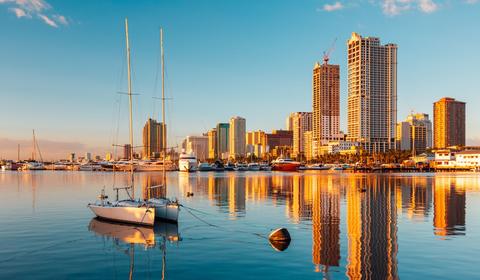
POWERING THE FUTURE: NAVIGATING THE ENERGY TRANSITION IN THE PHILIPPINES
As the world races towards a sustainable and greener future, the Philippines finds itself at a crucial juncture in its energy landscape. The country, blessed with abundant natural resources and a rapidly growing economy, is confronted with the imperative to transition from traditional fossil fuels to cleaner, more sustainable energy sources.
While it has every intention to give itself the best environment to transition to clean energy fuels and technologies, it also must balance an interesting yet delicate dynamic between its renewable energy ambitions and cost considerations. What will aid the Philippines in its plan is the comprehensive policies the Government has put in place and the prices of renewable energy technologies that have become more competitive, allowing the country to expect an increase of investments in renewable energy projects.
The Present Energy Landscape
The Philippines has historically been heavily reliant on coal and oil for its energy needs, which greatly contributes to environmental degradation and vulnerability to global energy price fluctuations. Approximately 61% of the country's electricity generation comes from coal, with oil-based power plants also playing a significant role. This over-reliance on fossil fuels poses considerable risks, both in terms of environmental sustainability and energy security.
In terms of untapped renewable energy potential, the Philippines has an estimated 246,000 megawatts (MW) of untapped renewable energy. The country’s current mix of renewable energy consists of 4.3 gigawatts (GW) of hydropower, 896 MW from solar energy, and wind 427 MW.
It has the world’s third-largest geothermal capacity at 1,900 MW with Indonesia in second and the US on top.
Yet, the Philippines is the only ASEAN country that has not committed to a net zero target. As with all developing countries that generally find renewable energy costs challenging, the Philippines will seek to balance the dynamics between its renewable energy ambitions and cost considerations. The general outlook looks increasingly promising, and it is well positioned for more renewable development in terms of policies, procurement, and economics.
Government Initiatives
As part of its roadmap to achieving its energy transition goals, the Philippines government has implemented a series of initiatives with ambitious targets:
- National Renewable Energy Roadmap (NREP): The Department of Energy (DOE) has laid out a clear roadmap to increase the share of renewables in the energy mix, aiming to achieve 35% by 2030.
- Renewable Portfolio Standards (RPS): The Philippines implemented an RPS policy, which requires electricity suppliers to source a certain percentage of their energy from renewable sources. This policy encourages power producers to invest in and use renewable energy.
- Green Energy Option Program (GEOP): The GEOP allows consumers, including residential and commercial customers, to choose renewable energy sources as their power supply. This initiative empowers individuals and businesses to make greener choices.
- Feed-in Tariffs (FiT): The FiT system guarantees fixed payments for electricity generated from renewable sources. It provides a level of financial security for investors and renewable energy project developers.
- Green Finance: The government is promoting green finance mechanisms to attract investment in renewable energy projects, including partnerships with international financial institutions.
- Energy Efficiency: Initiatives to improve energy efficiency in all sectors, from transportation to industry, are being developed to reduce overall energy consumption.
- Community-Based Renewable Energy Projects: Encouraging local communities to participate in renewable energy projects can stimulate rural development and empower local stakeholders.
Specifically, the National Renewable Energy Program (NREP) 2020-2040 sets an aspirational target that adheres to the Renewable Portfolio Standard (RPS) goal of increasing the share of renewable energy in the total power generation mix to 35% by 2030 and 50% by 2040 with a 50% share equivalent to 73.9 GW of additional renewable energy capacities by 2040.
Report Findings
From the Department of Energy report “2020-2040: Philippine Energy Plan”, it is estimated that to achieve the target, the country needs pre-development investments of about PhP25.3 billion and the construction of these RE power projects will require PhP5.8 trillion in investments. Moreover, for the next 10 years, the rehabilitation, expansion and development of new substations, transmission backbone projects and island interconnection projects demand PhP348.4 billion in financing support. On a per grid basis, the Luzon grid gets PhP100.5 billion from new transmission line project, Visayas grid with PhP162.1 billion and Mindanao grid with PhP85.8 billion.
While the entry of renewable energy projects provides opportunities to grow the economy of the country and decarbonise the power grid, it does have several challenges that come with it. Challenges that may arise are attributed to the grid’s resiliency and stability, backup power during power outages, associated cost of meeting peak demand power as well as transmission infrastructure costs. Thus, the need for a solution is urgent while being parallel to the growth of the renewable energy sector.
The energy storage industry has been the immediate answer to the situation where we had seen unprecedented growth in the last year. However, we’re only at the beginning of an exponential growth curve, with current deployment levels several orders of magnitude below the aggregate generation capacity of the grid. There is a long way to go before storage starts realising all its intended benefits.
In the coming years, energy storage systems will be critical to making the grid more flexible. It will also be integral to making renewable energy sources, like wind and solar, financially and logistically viable. The energy storage systems provide several benefits to the grid. When co-located with renewable energy plants, these systems can store excess clean energy generated and then deliver it to the grid when needed. This helps balance supply and demand and stabilise the grid during peak periods, without using costly polluting peaking plants. With batteries to bridge the gap during extreme weather conditions, electricity prices can be stabilised, mitigating risk, and supporting operational continuity for energy users.
Nowadays, batteries are the most scalable type of grid-scale storage, and the market has seen strong growth in recent years. Other storage technologies include compressed air, pumped storage that during off-peak hours, turbines pump water to an elevated reservoir using the excess electricity. All these potential solutions to these challenges exist but surely it requires customisation to address specific issues and concerns. What remains to be addressed are, as follows:
- How can the financial and technical challenges associated with integrating energy storage systems into renewable energy projects be overcome?
- What key factors determine the success of energy storage in relation to grid stabilization and renewables integration?
- How can policymakers, regulators, and industry stakeholders collaborate to create a supportive environment that encourages the deployment of energy storage systems and fosters the growth of renewable energy integration?
The Trusted Partner in Philippines’s Energy Transition
The energy transition in the Philippines represents not only a challenge but a tremendous opportunity. With abundant renewable energy resources, a growing economy, and proactive government policies, the nation is well-positioned to embark on a sustainable energy journey. The transition will not only reduce greenhouse gas emissions and enhance energy security but also stimulate economic growth and improve the quality of life for all Filipinos.
However, addressing challenges such as infrastructure development, policy support, and the technical skills gap is essential for the country to fully realise the benefits of this energy transition. Strategic planning, collaboration among stakeholders, and a commitment to long-term sustainability will be key to overcoming these challenges and achieving a greener and more secure energy future for the Philippines.
Bureau Veritas will play a vital role in addressing the concerns and foster stakeholder and public trust in energy projects. Collaboration between industry players, throughout the value chain, will be essential to develop the more efficient renewable assets and energy storage systems the world needs. For new technology to be adopted, it must be trusted. Customers want to know that technology is safe, reliable and performs to the level required. This means that developers have to secure the basics. Performance criteria including capacity and emissions profile are the factors on which innovations tend to be judged, but factors such as operational safety, quality and sustainability are equally important.
Leveraging our global reach and comprehensive service portfolio, we empower clients along the entire energy value chain to shape a net-zero future. Our owners’ engineering and technical advisory services enable us to help clients meet their acceleration challenges as they scale up projects worldwide. And our third-party assessments help de-risk innovation while our audits and digital tools support supply chain resilience. Bureau Veritas will support the industry to enable transformation and accelerate its transition.
As we look ahead, it is crucial for all stakeholders – government, industry, civil society and Bureau Veritas – to collaborate and drive this transformation toward a greener, more prosperous future for the Philippines and the planet as a whole.
Country Chief Executive
Bureau Veritas Philippines
Philippines has a tremendous opportunity to build towards a greener and prosperous future with comprehensive policies, growing economy and abundant renewable energy resources.
